Advanced Settings Screen Detail
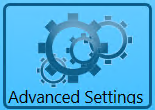 Clicking Advanced Settings displays the Advanced Settings screen.
Clicking Advanced Settings displays the Advanced Settings screen.
This screen is mainly intended for any troubleshooting that might be needed for PWC, specifically, through Window Book’s Support Team.
Window Book strongly recommends Mailers do not make any modifications to the settings found in this screen unless directed to do so by a Window Book Support Representative.
Below the print screen is an explanation:

![]() Maximum Number of Upload Processes: The PWC can handle the processing or uploading of multiple Mail.dat files residing in the Export folder simultaneously and for all MDR Client sites (PROD, TEM, CAT, and PREPROD). Depending on the mailer’s environment, size, and the number of Mail.dat files, the server specs the MDR Client is being run on, etc., system performance can be impacted. Therefore, this particular function can assist with optimizing system performance. The default value for this function is dependent on the system it is installed on: default = 4 for 64-bit systems.
Maximum Number of Upload Processes: The PWC can handle the processing or uploading of multiple Mail.dat files residing in the Export folder simultaneously and for all MDR Client sites (PROD, TEM, CAT, and PREPROD). Depending on the mailer’s environment, size, and the number of Mail.dat files, the server specs the MDR Client is being run on, etc., system performance can be impacted. Therefore, this particular function can assist with optimizing system performance. The default value for this function is dependent on the system it is installed on: default = 4 for 64-bit systems.
A value of 0 = “unlimited” and should not be used unless otherwise directed by a Window Book Representative, as it has the potential of spawning a lot of MDR Client sessions that use a large amount of memory. This change could result in a negative impact on system performance.
![]() PostalWeb Connector Logs section: PWC generates log files that record system processes and functions as they occur. They are crucial for troubleshooting should any operational issues arise. Log files are recorded daily, at the end of which they are archived on the server. At the end of one week, the system automatically purged these archives to avoid using unnecessary disk space. There are three parts to PWC Logs:
PostalWeb Connector Logs section: PWC generates log files that record system processes and functions as they occur. They are crucial for troubleshooting should any operational issues arise. Log files are recorded daily, at the end of which they are archived on the server. At the end of one week, the system automatically purged these archives to avoid using unnecessary disk space. There are three parts to PWC Logs:
-
 View Log: Clicking this button opens the current day’s log file. It displays "PWConnector.log" in Notepad.
View Log: Clicking this button opens the current day’s log file. It displays "PWConnector.log" in Notepad.
.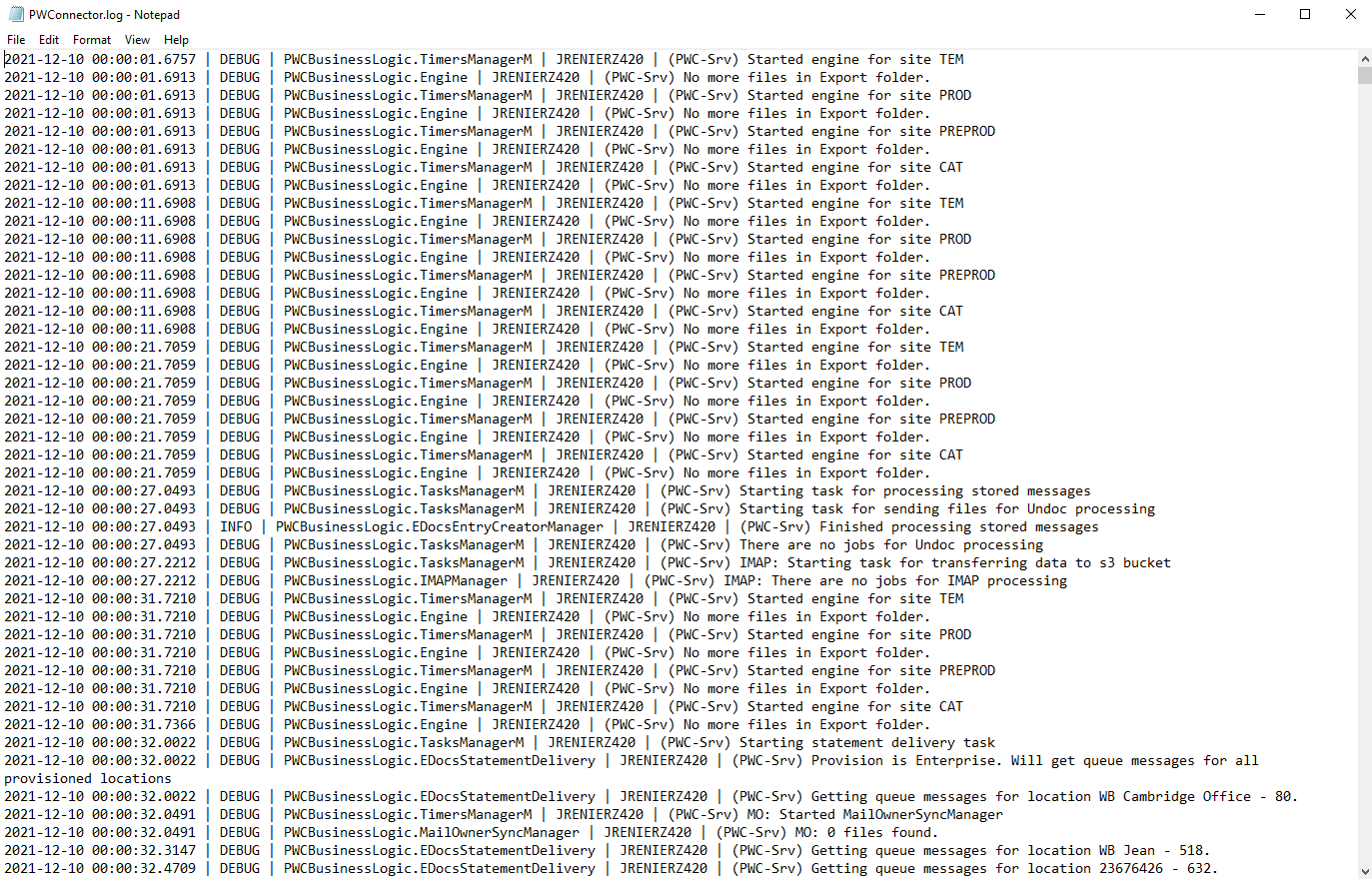
-
 Open Log Folder: Clicking this button opens a File Explorer screen and displays the existing log files for today and subfolders utilized for other functions.
Open Log Folder: Clicking this button opens a File Explorer screen and displays the existing log files for today and subfolders utilized for other functions.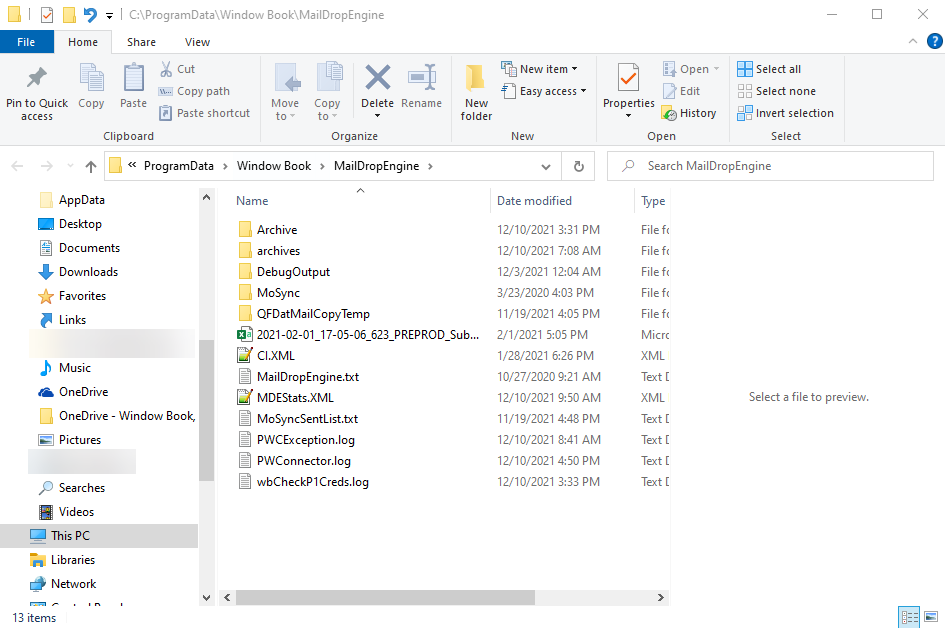
-
 Open Log Archive Folder: Clicking this button opens a File Explorer screen and displays the archived log files.
Open Log Archive Folder: Clicking this button opens a File Explorer screen and displays the archived log files.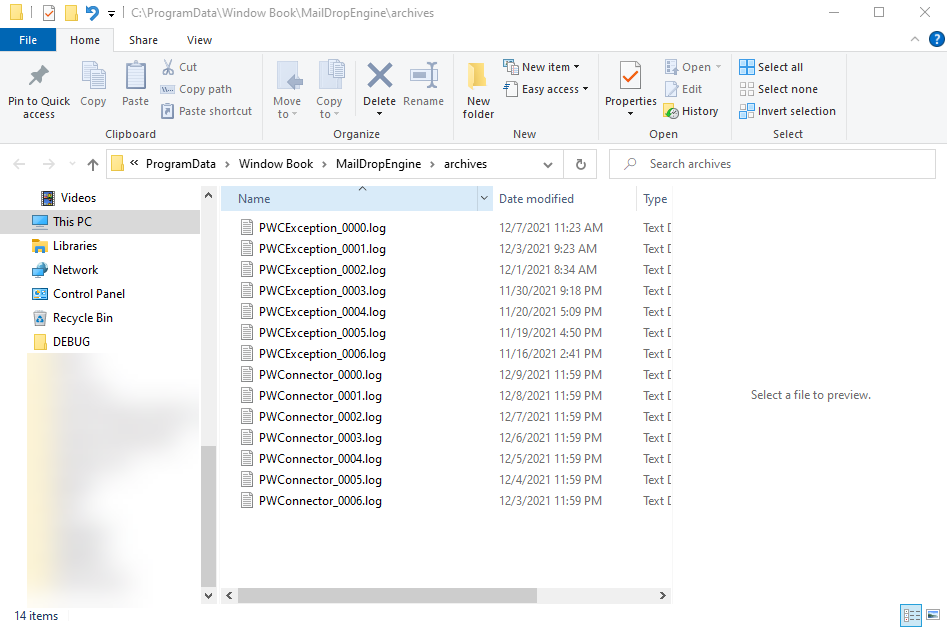
![]() Mail.dat Logging Level section: This area of the Advanced Settings screen displays two tables containing the following columns, which provide access to the USPS log files used to troubleshoot the MDR Client.
Mail.dat Logging Level section: This area of the Advanced Settings screen displays two tables containing the following columns, which provide access to the USPS log files used to troubleshoot the MDR Client.
Below this image is an explanation of each column in the Mail.dat Logging Level Section of the Advanced Settings Screen:
-
USPS® Site: Lists each possible MDR Client site (PROD, PREPROD, CAT, and TEM).
-
Current Logging Level: The logging level refers to the system's types of messages sent to the client.log and debug.log files. These log files are used for troubleshooting purposes, so the more detail the files contain, the easier it is to troubleshoot. However, this also increases file size and uses more system resources. The two logging levels readily available to you are “DEBUG” (default – less detail and on the screen the column field value is blank) and “TRACE” (highest amount of detail – uses most system resources). This entry or value displayed in this field is reported by the system and cannot be edited.
If an MDR Client site is not installed, the entry displayed in this column is “UNKNOWN.” Once the site is installed and the PostalOne! credentials are authenticated, the entry displayed will change to the default "Debug"). To change the logging level to "TRACE," refer to the next bullet item below, “Change Level To.”
Window Book does not recommend switching to the TRACE logging level unless directed by a Window Book Support Representative.
Additional logging levels are available (all contain less detail than DEBUG and TRACE). The specific properties file that dictates what level of detail or what type of messages are sent to the log files by the system can be edited to use a logging level other than Debug or TRACE). Only advanced users or a qualified Window Book Representative should perform.
-
Change Level To: The two logging levels readily available to the Client are “DEBUG” (default –minor detail) and “TRACE” (highest amount of detail – uses most system resources). This column displays the available logging level option that is not currently in use. So for example, if the Current Logging Level: shows "DEBUG," this column will show "TRACE." If the MDR Client site is not installed or the PostalOne! credentials have not been authenticated for an MDR Client site, the value displayed in the site’s corresponding column will be “File is Missing.”
-
Debug.log: If an MDR Client site is installed and the PostalOne! credentials have authenticated successfully, the open-folder View will display in this column for that MDR Client site. Clicking View
 displays the "debug.log" file in Notepad.
displays the "debug.log" file in Notepad. 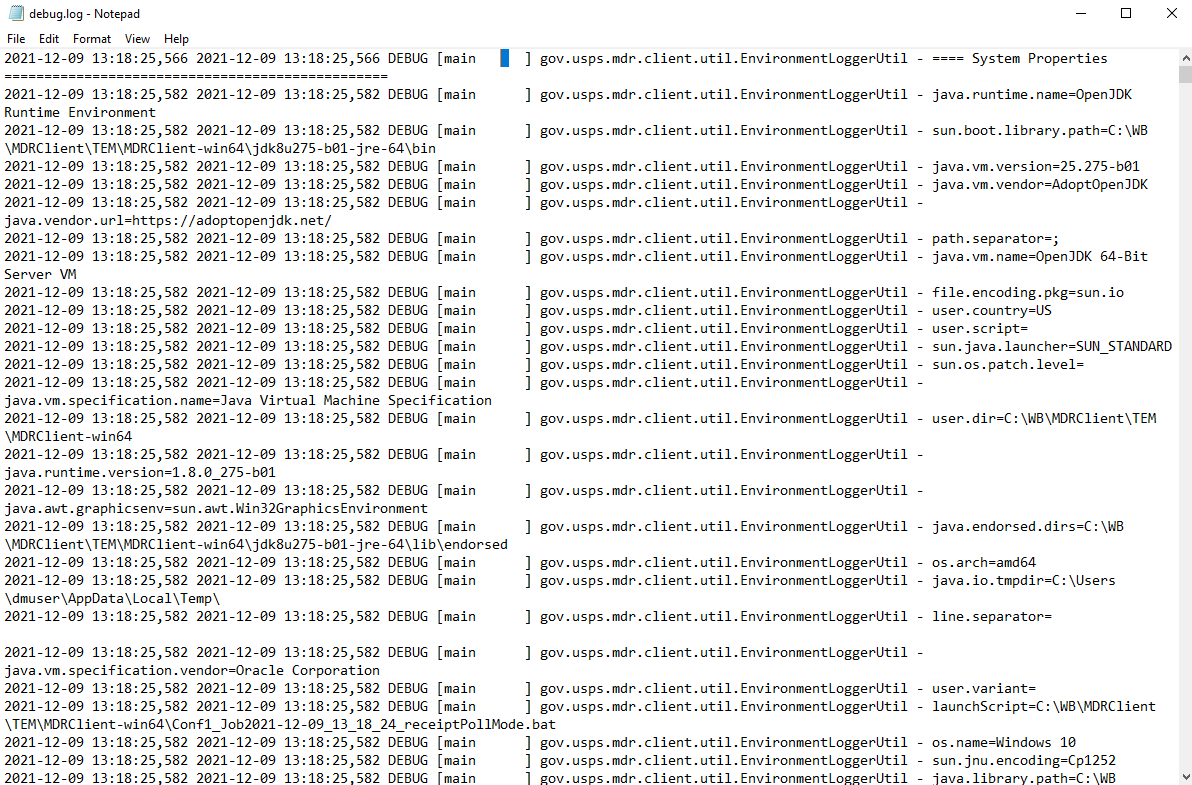
-
MDR Client: If an MDR Client site is installed and the PostalOne! credentials have authenticated successfully, an open-folder
 Open will display in this column for that MDR Client site. Clicking Open
Open will display in this column for that MDR Client site. Clicking Open  will open the corresponding MDR Client folder on the server.
will open the corresponding MDR Client folder on the server.
![]() Clean up DataBase Log WBDB: This section of the Advanced Settings screen allows you to view the size of their existing ‘WBDB’ database log file and shrink it to a more manageable size. This clean-up is done by selecting a size from the Shrink Log File Size To drop-down provided and then clicking Shrink Log
Clean up DataBase Log WBDB: This section of the Advanced Settings screen allows you to view the size of their existing ‘WBDB’ database log file and shrink it to a more manageable size. This clean-up is done by selecting a size from the Shrink Log File Size To drop-down provided and then clicking Shrink Log  .
.

![]() Clean up DataBase Log WBDBCLA: This section of the Advanced Settings screen allows Clients to view the size of their existing ‘WBDBCLA’ database log file and shrink it to a more manageable size. This clean-up is done by selecting a size from the Shrink Log File Size To drop-down provided and clicking Shrink Log
Clean up DataBase Log WBDBCLA: This section of the Advanced Settings screen allows Clients to view the size of their existing ‘WBDBCLA’ database log file and shrink it to a more manageable size. This clean-up is done by selecting a size from the Shrink Log File Size To drop-down provided and clicking Shrink Log  .
.

Clean up Database log WBDB, and WBDBCLA should only be done if your Company is not utilizing the SQL Transaction Logs for disaster recovery. Using the above features will corrupt the logs if your Company uses these logs. Your SQL Server Administrator needs to be involved in backing up these transaction logs and databases regularly. Suppose your Company is not using the SQL Transaction Logs for disaster recovery. In that case, Window Book recommends performing either or both cleanup database actions during off-peak hours to ensure other WBI applications are not busy accessing either database.
![]() Java Batch Output: This option is for troubleshooting purposes and should only ever be enabled by a Window Book Support Representative! This option was coded to disable itself and delete data after 72 hours if not disabled intentionally by a Window Book Representative.
Java Batch Output: This option is for troubleshooting purposes and should only ever be enabled by a Window Book Support Representative! This option was coded to disable itself and delete data after 72 hours if not disabled intentionally by a Window Book Representative.

![]() Clean Up Tables and Files: This section of the Advanced Settings screen allows you to clean up their SQL tables and files right from the PWC. Clean-up can be performed for tables, files, or both.
Clean Up Tables and Files: This section of the Advanced Settings screen allows you to clean up their SQL tables and files right from the PWC. Clean-up can be performed for tables, files, or both.

 View Tables Cleanup: Clicking this button displays a Clean up Tables window. Table clean-up options are available for the records found in the MDSMJob, MDSMDL, MDSMVL, MDSMReceipt, and MDSMStatus tables. In addition, the total number of records in each table is provided, along with each table's disk space currently being used. Each table’s line item will also update and show how many records will be deleted based on that date when a date is selected.
View Tables Cleanup: Clicking this button displays a Clean up Tables window. Table clean-up options are available for the records found in the MDSMJob, MDSMDL, MDSMVL, MDSMReceipt, and MDSMStatus tables. In addition, the total number of records in each table is provided, along with each table's disk space currently being used. Each table’s line item will also update and show how many records will be deleted based on that date when a date is selected.
Tables and Files can be cleaned up together using the Clean All option, shown after covering View Files Cleanup.
Window Book requires that at least 120 days of Table data be maintained and at least ten days' worth of Files be maintained at all times. Users will only select a date older than the required retention period from the current date.
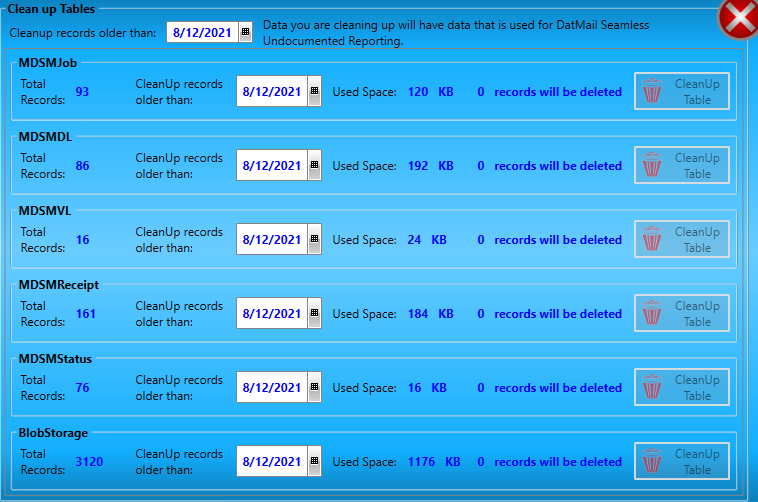
-
Selecting a date and then clicking CleanUp Table for a specific table will display a Confirm dialog.
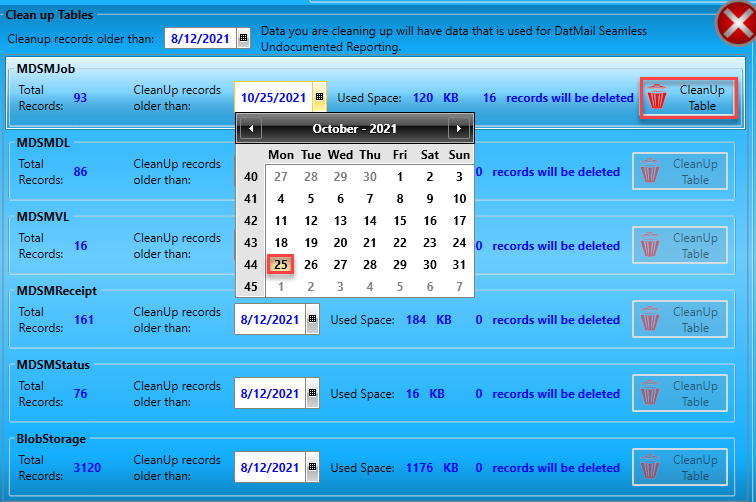
-
Click OK to close the dialog and continue with the delete process.
-
Click the ‘X’ located in the top right corner to close the Clean up Tables window.
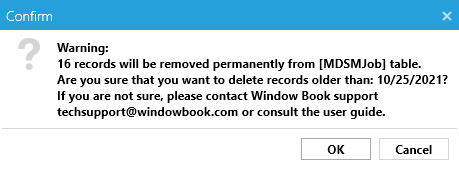
 View Files Cleanup: Clicking this button displays a Clean Up Files window. Files generated during the upload process for each MDR Client site are stored on the server. Over time, the number of files kept can affect system resources and performance. All the files are stored in their respective folders within each MDR Client environment (PROD, TEM, PREPROD, and CAT. The current size of each folder is displayed. When a date is selected, the amount of space freed up by deleting the files is displayed, and how many files will be removed.
View Files Cleanup: Clicking this button displays a Clean Up Files window. Files generated during the upload process for each MDR Client site are stored on the server. Over time, the number of files kept can affect system resources and performance. All the files are stored in their respective folders within each MDR Client environment (PROD, TEM, PREPROD, and CAT. The current size of each folder is displayed. When a date is selected, the amount of space freed up by deleting the files is displayed, and how many files will be removed.
-
In this example of the Clean up Files screen, screen below, 13 files in the TEM environment are available to delete, and by clicking CleanUp Folder, they can be removed.
Repeat this for each MDR Client environment you have installed.
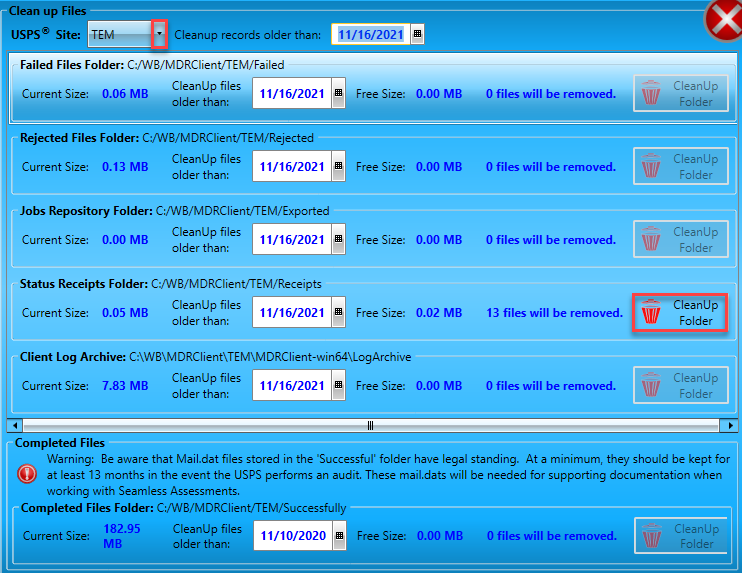
-
And like Clean up Tables, when you select CleanUp Folder, a Confirm dialog will appear, click OK to delete.
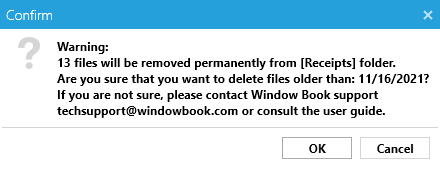
-
After the deletion is complete, click the ‘X’ in the top right corner to close Clean up Files.
Completed Files (Successful folder) are separated and appear at the bottom of the screen with a different default clean-up date since they have legal standing and should, at a minimum, be kept for at least 13 months.
 Clean All: If you do not need to review either the Clean up Tables or Clean up Files screen and you want to quickly clean all tables and files (files for all MDR Clients) older than a set date.
Clean All: If you do not need to review either the Clean up Tables or Clean up Files screen and you want to quickly clean all tables and files (files for all MDR Clients) older than a set date.
-
Set the date in the Cleanup records older than: section and then click
 Clean All.
Clean All.
-
When the Confirm dialog appears, click OK.
If you are running undocumented reports in DAT-MAIL or sending data to the Intelligent Mail Assessment Platform, you need to decide how long data must be kept. If you have any questions, please contact a Window Book Support Representative.
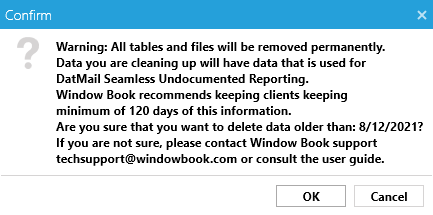
![]() MDR Clients Auto Update: Select this checkbox to disable the MDR Client Auto Update feature.
MDR Clients Auto Update: Select this checkbox to disable the MDR Client Auto Update feature.
This feature is intended for Clients who prefer to test MDR Client's functions before updating to a new MDR Client in PWC. Using this option will automatically tell the PWC not to download a new MDR Client.
When the ‘MDR Clients Auto Update’ option is enabled, the PWC will not process any files with an expired MDR Client until an active USPS MDR Client is installed. Clients who have questions about this option should contact Window Book Support (see Contact Us).
![]() PostalOne issue detecting: PWC includes a feature intended to make users of the PWC and the PWDD aware when PostalOne! is down. At that point, you can either contact the USPS Help Desk or wait a bit to see if the issue gets corrected resolved on its own. This feature looks for specific messages in the USPS MDR debug logs. When the PWC sees those errors, it notifies you via email. Also, a pop-up will appear notifying any user that it is down. If you wish to turn this feature off, select this checkbox and stop and start the PWC service.
PostalOne issue detecting: PWC includes a feature intended to make users of the PWC and the PWDD aware when PostalOne! is down. At that point, you can either contact the USPS Help Desk or wait a bit to see if the issue gets corrected resolved on its own. This feature looks for specific messages in the USPS MDR debug logs. When the PWC sees those errors, it notifies you via email. Also, a pop-up will appear notifying any user that it is down. If you wish to turn this feature off, select this checkbox and stop and start the PWC service.
![]() Automatically Clean up Tables: For Clients who have a large volume of records being generated by MDR Clients, having to get to the server to be able to access and use the manual View Tables Cleanup function every few days can be cumbersome and time-consuming; therefore, Window Book has included an automatic delete function for the specific tables that are affected, specifically the ‘debug.log’ (also known as the “MDSMDL” table); ‘validation.log’ (also known as the “MDSMVL” table); and ‘Event.log’ (also known as the “MDSMReceipt” table). The PWC will automatically delete records based on the number of days set.
Automatically Clean up Tables: For Clients who have a large volume of records being generated by MDR Clients, having to get to the server to be able to access and use the manual View Tables Cleanup function every few days can be cumbersome and time-consuming; therefore, Window Book has included an automatic delete function for the specific tables that are affected, specifically the ‘debug.log’ (also known as the “MDSMDL” table); ‘validation.log’ (also known as the “MDSMVL” table); and ‘Event.log’ (also known as the “MDSMReceipt” table). The PWC will automatically delete records based on the number of days set.
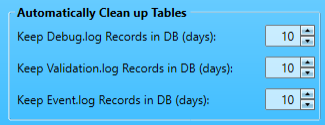
Continue DAT-PreCheck (DPC) Screen Detail